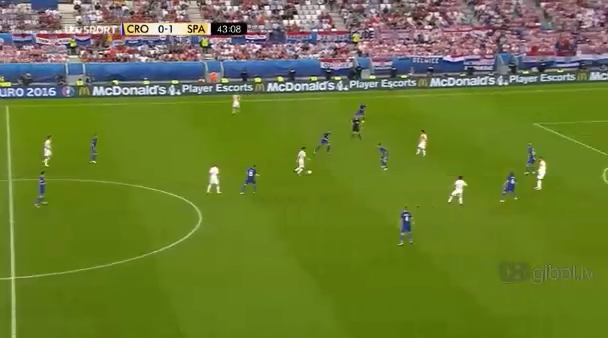James Sutherland tactically analyses Croatia’s 2-1 victory over Spain that set up an interesting knock-out stage for the European Championship.
The last match of the group stage for both teams, Spain and Croatia were the leaders of Group D. Both had also already clinched qualification for the next round, meaning that it seemed this game would be meaningless. But it turned out to be anything but a run-through. Croatia came out to play, looking for a win that would propel them into first place in the group, while Spain looked for a reassuring win, calming their fans and critics after some shaky play to start the tournament.

Croatia (4-2-3-1): Subasic; Vrsaljko, Jedvaj, Corluka, Srna; Badelj, Rog; Pjaca, Rakitic, Perisic; Kalinic
Spain (4-3-3): De Gea; Alba, Ramos, Pique, Juanfran; Iniesta, Busquets, Fabregas; Nolito, Morata, Silva
Vicente Del Bosque stuck with the same lineup that he used in the first two group games, looking for continuity and stability. It is filled with playmakers, including Iniesta, Fabregas and Silva, as well as Busquets in a deeper role. Spain defended mostly in a 4-1-4-1, with Busquets dropping as a pivot between the defense and midfield. Occasionally one of the center midfielders, either Iniesta or Fabregas, would press up next to Morata and Busquets would fill the space, creating a 4-4-2.
Ante Cacic, on the other hand, had to replace Luka Modric, his star. Modric left Croatia’s second match, against the Czech Republic, with an injury, so Cacic had to replace Croatia’s main playmaker. He brought in Marko Rog, a 20 year old midfield for Dinamo Zagreb. Although Croatia lined up in a 4-2-3-1, they truly defended in a 4-4-2.
Croatia came out with an ambitious and aggressive game plan. Instead of looking to sit deep and allow Spain to control the ball, Cacic decided to press high and disrupt Spain’s build up in the first line, taking the game to the European champions.
Ivan Rakitic pushed up alongside Nikola Kalinic, while Ivan Perisic and Marko Pjaca dropped back into midfield to create a 4-4-2. While this is an effective formation to press in, as it offers good vertical compactness and support for the first line of pressure when executed right, Croatia failed to do that. Their pressure did disrupt Spain’s initial build up some, but the Spanish also easily found ways around it, and behind the pressure was open field.
There are two main rules that every team must follow when they defend higher up the field: put pressure on the ball and in midfield, and stay compact between lines of defenders. Croatia did neither. Often Sergio Ramos and Pique would pick up the ball from David De Gea, and find themselves with space and time to dribble calmly and look for a pass. Rakitic and Kalinic failed to put adequate pressure on Spain’s centerbacks, a general flaw but exacerbated by the offensive ability of Ramos and Pique.
This lack of ball pressure was made worse by the complete lack of compactness. The central midfielders were often 20-30 yards behind the Rakitic and Kalinic, leaving acres of space for Busquets, Iniesta and Fabregas to move in. Spain’s goal shows the result of that uncompactness.

Ramos has the ball in the left halfspace, with Rakitic shadowing his movement, but not pressuring. Busquets is between Rakitic and Kalinic, with easy access to the ball, and no midfielder nearby to pressure his receiving of the ball.

Ramos and Busquets trade passes, opening room for Iniesta in the left halfspace. Although Rog has moved up, he isn’t close enough, and Iniesta is in a good position to receive the pass and deal with pressure.

Iniesta touches the ball into Busquets in the middle. Look at the space he has as he moves up the field: there isn’t a defender within 10 yards of him. Affording this sort of space to any passer, much less Busquets, is disastrous, especially when players up the field are also open. Fabregas is wide open in the right half space at the bottom of the photo.

With one diagonal pass, Busquets has passed another of Croatia’s line. Now Fabregas has the ball, running at Croatia’s backline with space and time to make a pass. Morata makes a good run into the right half space, although the pass is blocked. The ball rolls out to the wing, where David Silva dribbles the ball back into the center. Two fantastic passes later, Spain has taken the lead.
Spain didn’t just exploit Croatia’s uncompactness in pressing, though. When Croatia dropped deeper, they still left space between their lines for Spain to use. Silva and Fabregas were especially effective for Spain in the opposition half, as Croatia’s central midfielders left the 10 space open often. This allowed Silva especially, who was playing on the wing, to find space in the center that wasn’t occupied by another of Spain’s midfielders.

Here Busquets can see Fabregas in the middle, between two lines of Croatia’s defenders. It isn’t an easy pass to make, but Busquets has the skill to make it, and when completed, it cuts through Croatia.

Fabregas turns on the ball well, and has several options ahead of him. Although there are several Croatians in front of him, they aren’t spaced well, leaving passing lanes. There is a 3 v. 2 ahead of Fabregas: Corluka and Jedvaj have to cover Silva, Morata and Nolito. Fabregas eventually plays a brilliant through ball for Morata, and if he hadn’t taken an awful first touch Morata would have had an open shot on goal. The movement of Nolito was especially important, as Jedvaj moved up to track him, leaving space behind Corluka, who foolishly steps out to mark Silva, for Morata to run.
Both Nolito and Silva acted as inverted wingers, cutting into the halfspaces with and without the ball. Silva had more of a free role than Nolito, often floating as far as the other halfspace, to create overloads and combinations.

The inward movements of the wingers opened space for Spain’s fullbacks to make overlapping runs and move higher up the field. Jordi Alba was very important to Spain in this sense, as he provided width when Nolito moved into the center, and also was available to create overloads on the left side.

Spain have created a 5 v. 5 here, not quite an overload, but it could easily become one. Nolito and Morata are in the half space, on Croatia’s last line of defense. Alba has pushed higher up the wing, while Fabregas dropped deeper to cover for him. Iniesta is also nearby, linking play back into the center of the field.
Cacic recognized the issues his side had defensively, and made halftime changes. In the second half Croatia mostly sat deeper and more compact, most importantly. Although they did on occasion press higher, after equalizing at the end of the first 45 they seemed happy to allow Spain to hold the ball. More compact, they were better able to stall Spain’s possession.

Spain didn’t help themselves by having some structural issues in possession. For example, as you can see above, Spain often had too many players on the same horizontal line of possession, breaking one of the fundamental rules of positional play. Also, as the game wore on Del Bosque made some substitutions, most importantly taking Nolito off for Bruno, a holding midfielder. This reduced Spain’s ability to penetrate Croatia’s lines, and created more of a clog in midfield.
Croatia’s compactness can also be seen above. The midfield and defense are much tighter, with little room left in the 10 space. The fullbacks and wide midfielders also traded fairly regularly, with the fullbacks tracking Silva and Nolito inside.
Croatia increasingly hit Spain with quick vertical counters as the second half continued. With the speed of Perisic and Pjaca on the wings, and Rakitic and Kalinic in the center, Croatia was able to exploit Spain’s weak counterpress to create chances. It was a long spell of Spanish possession that Croatia won the ball back and Perisic dribbled up the field, before slotting home the winning goal.
Conclusion
This game was one of the best at the Euros so far. An interesting tactical battle, the closeness of the two teams was reflected in the scoreline. The expected goals tally mirrors that tightness as well, with Spain slightly underperforming in finishing.
xG map for #CRO–#ESP. Really impressive performance by heavily second-string #CRO side. Spain are still good tho. pic.twitter.com/5ruEVJbkU5
— Michael Caley (@MC_of_A) June 21, 2016
Croatia won the group because of this win, and beyond the joy of beating the two time defending European champions, they escaped the death bracket, instead playing Portugal. A massive result for them, the Croatians must be one of the teams to watch on that side.
Spain lost this game on multiple fronts, just as Croatia won it on multiple. They lost the game itself, failing at the last to secure three points. And they lost the group, meaning they have to play Italy, Germany and France just to get the chance to defend their title. Despite the loss and flawed performance, they look one of the more dangerous sides in the tournament, and Italy will be just as disappointed by the result.
Written by James Sutherland
- Tactical Analysis: Sevilla 2-1 Real Madrid | Sevilla finally end the unbeaten streak - January 21, 2017
- Tactical Analysis: Borussia Dortmund 8-4 Legia Warsaw | Defence thrown out of the windows - November 27, 2016
- Tactical Analysis: RB Leipzig 1-0 Borussia Dortmund | Leipzing outpress Dortmund - September 18, 2016























































